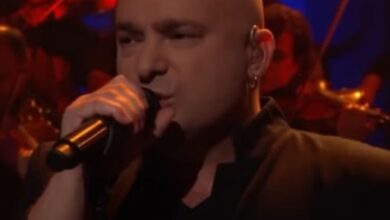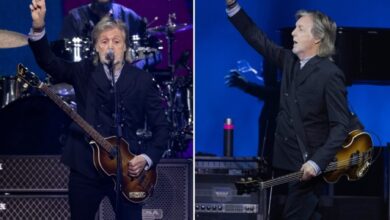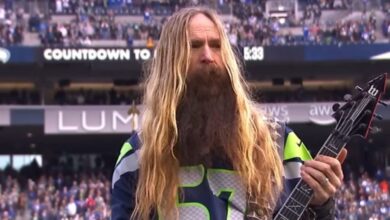Metallica’s ‘Whiskey in the Jar’ Ignites Levi’s Stadium Homecoming on June 22, 2025
Metallica’s second Bay Area stop on the M72 “No Repeat Weekend” erupted into something special when the opening riff of “Whiskey in the Jar” rang out across Levi’s Stadium on June 22, 2025. More than 50,000 fans—many in black “Kill ’Em All” shirts faded by decades of devotion—roared at the surprise inclusion, a mid-set curveball wedged between “The Unforgiven” and “Blackened.” For a band renowned for surgical setlist planning, reviving this folk-metal hybrid after years of absence felt like a message: even after forty-plus years, Metallica can still ambush its own crowd.
Long before they were stadium mainstays, the band built its legend in rehearsal rooms scattered around San Francisco’s East Bay. James Hetfield’s precision down-picking, Lars Ulrich’s manic double-kick patterns, Kirk Hammett’s wah-drenched solos, and Robert Trujillo’s spider-fingered bass gymnastics fuse into a signature that is at once brutally tight and oddly communal. Their Bay Area roots run deep; a Santa Clara gig is more family reunion than tour stop, steeped in neighborhood pride and memories of early shows at the Old Waldorf where amps rattled ceiling tiles loose.
“Whiskey in the Jar” itself predates every member of Metallica by centuries. The song began life as an Irish highwayman’s ballad, found new electricity in Thin Lizzy’s swaggering 1972 rock version, and finally gained metallic muscle on Metallica’s 1998 Garage Inc. sessions. Hetfield later joked that recording the tune felt like “borrowing Phil Lynott’s leather jacket and finding it still fit,” an off-the-cuff remark that captured the band’s reverence for its influences.
The 1998 cut emerged from sessions at The Plant in Sausalito, co-produced by Hetfield, Ulrich, and veteran engineer Bob Rock. Instead of layering multiple guitars, Rock insisted on a single, hulking rhythm track from Hetfield, doubled only for stereo thickness. Hammett countered with a solo heavy on Celtic pentatonic bends, while Ulrich abandoned thrash tempos in favor of a swinging, half-time groove. Trujillo hadn’t joined the band yet—Jason Newsted handled bass—so onstage in 2025, Trujillo stamps the bass line with flamenco-flavored finger work he perfected decades later.
Upon release, Metallica’s “Whiskey in the Jar” stormed MTV’s Total Request Live and earned the 2000 Grammy for Best Hard Rock Performance, an accolade that amused purists who couldn’t decide if it was hard rock, heavy metal, or folk in battle armor. Chart-wise, the single cracked Billboard’s Mainstream Rock Top 10, an impressive run for a cover derived from a 17th-century rebel chant.
Culturally, the track became a gateway for non-metal listeners who found Metallica’s originals too abrasive. Radio programmers slotted it between Matchbox Twenty and Dave Matthews, exposing suburban carpool lanes to a band otherwise synonymous with mosh pits. For Metallica, it proved versatility wasn’t a betrayal of roots but an expansion of them.
That versatility paid off again in 2025. The Levi’s Stadium rendition, preceded by a playful jam in which Lars quoted an old Thin Lizzy drum fill, reminded longtime fans of Metallica’s knack for honoring heroes without abandoning identity. The roar that greeted the first chorus echoed the band’s 1999 S&M shows with the San Francisco Symphony, another moment when purists predicted disaster and were instead handed history.
Beyond Metallica, the success of this cover nudged folk standards into hard-rock wardrobes. Bands from Dropkick Murphys to Alestorm cite Metallica’s arrangement as proof that sea shanties and power chords can coexist. Countless bar bands still kick off St. Patrick’s Day sets by yelling “Mush-a, mush-a” in Hetfield’s gravelly timbre.
Not surprisingly, “Whiskey in the Jar” has enjoyed its own parade of reinterpretations. Thin Lizzy’s twin-lead guitar version remains canonical, yet U2 toyed with it during a Dublin sound-check in 2015, and even Ed Sheeran slipped a snippet into a 2019 arena medley. None approach Metallica’s iron-fisted swing, but each cover underscores the song’s strange portability across genres and generations.
June 2025 found Metallica personally at peace yet professionally restless. Hetfield’s rehab return in 2022 had sharpened his vocals; Hammett embraced a more improvisational soloing style after pandemic practice deep dives; Trujillo brought his trademark helicopter-spin jump back into the spotlight; Ulrich, gleeful as ever, teased that the Bay Area air “still smells like home.” Local newspapers framed the night as a victorious exhale after global turbulence.
In legacy terms, “Whiskey in the Jar” endures as the rare cover fans treat like original canon, helped by the Grammy win and its omnipresence on Garage Inc.—still one of the best-selling cover albums ever released by a metal act. Spotify streams topped 400 million early in 2025, eclipsing many of the band’s original deep-cuts from the same era.
Musically, the track foreshadowed Metallica’s willingness to down-shift tempos, a move that would resurface on ballads like “Inamorata” from 72 Seasons. Its open E-minor riff, anchored by spacious drum accents, widened the sonic palette for later mid-tempo crushers such as “Moth Into Flame,” heard just four songs after it on the Santa Clara setlist.
Though no one onstage mentioned it outright, the 2025 performance effectively marked the song’s 25th anniversary in Metallica’s catalog. Fans brandished homemade banners reading “Jarheads Since ’98,” and Hetfield winked into the camera during the final chorus, acknowledging the milestone without sermonizing.
As the band launched into “Blackened” right after the final “Whack for my daddy-O,” the stadium lights flared crimson and gold—a callback to the Load era’s fiery artwork. It was a visual reminder that even at homecoming shows, Metallica stitches every era of its quilt together in real time.
By the encore’s end, a cool coastal breeze had rolled in from the San Francisco Bay, tangling hair, cooling sweat, and carrying the lingering chorus of “Whiskey in the Jar” into the night sky. In a career defined by towering originals, this centuries-old folk tale—filtered through Lynott’s swagger and Hetfield’s snarl—still commands the spotlight, proving that great songs, like great bands, never stop evolving.





